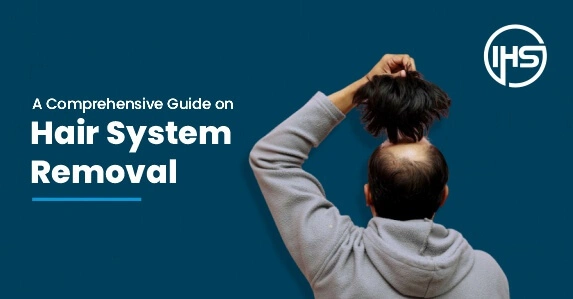



Contact our specialists now for Hair Replacement!
The two questions always hit our minds when we are getting the hair replacement system done, can you guess those questions? Fine let us give you a hint, those questions are related to your appearance, now any guesses? Never mind, let us do that for you!
So the first question would always be this: Does the hair system look good on me? And- the second one would be, now that I have started wearing the hair system, what am I supposed to do if I want to remove it? Huh? I think I should watch a YouTube tutorial, or not let me just ask my friend because he is always wearing a hair system, is this you? Oh yes, and we know that you can relate to this whole scenario, right?
So come let us understand how to remove the hair system easily, stay tuned to this blog till the end and you will get all your answers!
MYTH: Hair system removal is a painful process
FACT: Hair system removal, when done properly, should not be a painful process
Take out some amount of time – Before initiating the hair system removal process, it is essential to get a good amount of block to ensure a thorough and careful execution. Ensure that your schedule allows for several hours of uninterrupted focus before starting the task
The success lies in the solvent: At IHS London, we understand that selecting solvents can be tough for those unfamiliar with them. Rest assured there are solvents available with both custom-made and stock hair systems
In other words, solvents are specialized products designed to delicately eliminate stubborn adhesive residue without irritating your scalp or harming your hair system. Typically made of alcohol or citric oil bases, these solvents are available in both liquid and spray forms, providing you with versatile options for a seamless removal experience
PRO TIP: It is not at all suggested that you only use soap and water to remove your hair system
Pick the right solvent: Choosing the right solvent for your hair system is a crucial step in ensuring a comfortable removal process. The right solvent will ensure a clean and residue-free surface, promoting better adhesion during the next application
Removing a requires careful and gentle steps to ensure you don’t damage the hair system or harm your natural hair and skin. Here’s a step-by-step guide :
Step 1: Prepare the Area– Ensure you are doing the process in a well-lighten and comfortable space. Keep all the necessary materials in an instant reach
Step 2: Brush your hair system – Gently brush your hair system to remove any tangles or knots. This step helps in the even application of the solvent
Step 3: Apply solvent– Spray the solvent directly onto the areas where the adhesive or tape is attached. Hold the hair system, away from your face to avoid contact with the eyes
Step 4: Let the solvent sit– Allow the solvent to penetrate and loosen the adhesive for a few minutes. The specific duration may vary based on the solvent instructions, so check the product guidelines
Step 5: Begin removal– Starting from one edge, gently lift the hair system. Use a cotton ball soaked in solvent to dab on areas where the adhesive is still sticky. Continue lifting and applying solvent until the entire hair system is detached
Step 6: Clean residue– If any adhesive residue remains on your scalp or natural hair, apply a small amount of solvent to a cotton ball and gently rub the residue until it dissolves
Step 7: Shampoo your hair– Wash your natural hair with a mild shampoo to remove any remaining solvent or residue. Be gentle to avoid tangling your hair
Step 8: Condition your hair system – If your hair system is made of human hair, you can apply a small amount of conditioner to keep it soft and manageable
Step 9: Allow the hair system to dry– Let the hair system air dry naturally. Avoid using heat styling tools on the damp hair system
Expert ADVICE: After removal, cleanse your scalp with a mild, sulfate-free cleanser to ensure no adhesive residue remains on the skin
The type of adhesive used and its strength can affect how securely the hair system is attached. Strong adhesives may require less frequent removal, while weaker adhesives might necessitate more frequent adjustments
Tape: When utilizing double-sided tape to secure your hair system, the general recommendation is to remove and reapply it every 1 to 2 weeks
Glue: The duration of adhesive glue can vary based on the specific type of glue used and individual lifestyle factors. Typically, individuals may find it necessary to remove and reapply glue every 2 to 4 weeks
Bonding agents: Bonding agents such as liquid adhesives, are known for their robust adhesion. They often offer a secure hold, lasting anywhere from 3 to 6 weeks before necessitating removal and reapplication
Individual hair growth rates and scalp health can impact how often a person chooses to remove their hair system. Some may need to accommodate more frequent natural hair growth. Frequent removal and reattachment of a hair system can potentially irritate the scalp. It is essential to be attentive and observe any signs of discomfort, redness, or itchiness in the scalp with the hair system. If you notice persistent symptoms, it may be necessary to reconsider the frequency of removal
A person’s lifestyle and daily activities can impact how often they choose to remove their hair system. For individuals engaged in physical activities, sports, or activities that induce sweating, more frequent removal may be preferred to maintain cleanliness and hygiene
Regular maintenance, such as cleaning and conditioning the hair system, can influence the removal frequency. Individuals who prioritize proper care may feel more comfortable leaving the system in place for an extended period, while those who prefer frequent cleaning may opt for more regular removal
Some individuals prefer the convenience of a more permanent attachment, while others may prioritize changing their hairstyle frequently for a fresh look. Appearance preferences, including the desire for different styles or colors, can influence how often the hair system is removed and replaced
The condition of the scalp and skin underneath the hair system is crucial. Regular removal allows for proper inspection, cleaning, and care of the scalp, reducing the risk of skin issues. Individuals with sensitive skin may opt for more frequent removal to prevent irritation
The removal of a hair system is a process influenced by many factors that are related to individual preferences, lifestyle, and maintenance practices. The choice of adhesive type and attachment method, engaged with personal comfort levels, plays a significant role in determining how frequently one opts to remove their hair system. Lifestyle considerations, including daily activities and environmental factors, further contribute to this decision-making process
Ultimately, this comprehensive guide has highlighted the nature of hair system removal, emphasizing the importance of having the frequency to personal needs and preferences. Whether it’s achieving a secure, long-lasting attachment or opting for more regular changes to suit various styles, individuals can rely on the removal process with confidence by considering the diverse choices of factors discussed in this guide

IHS Hair Replacement is a hair replacement brand based in 2 prime locations, West Kensington in West London and Liverpool Street in Central London. We provide a full head of hair achieved through our hair integration procedure giving you confidence and life.